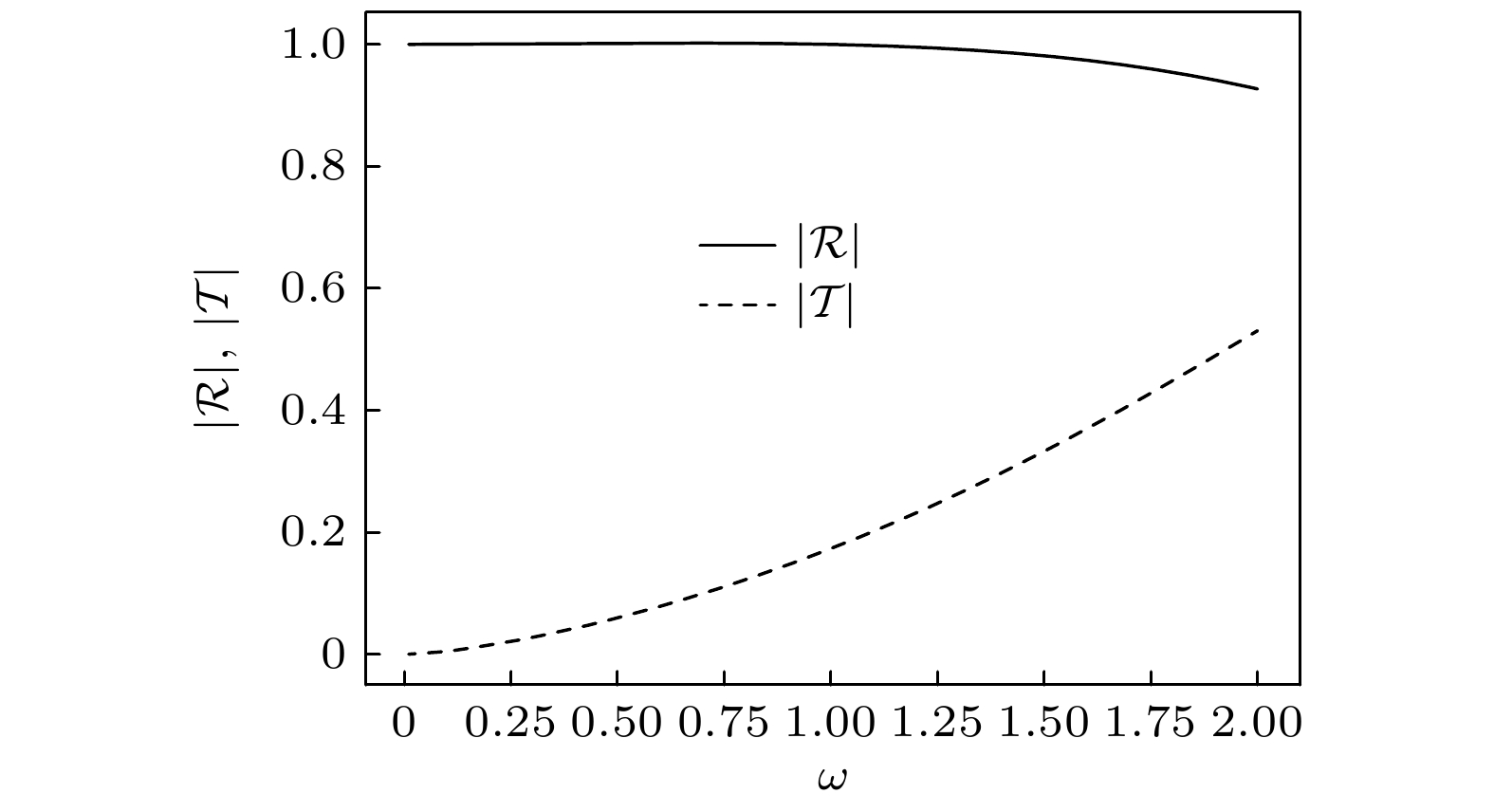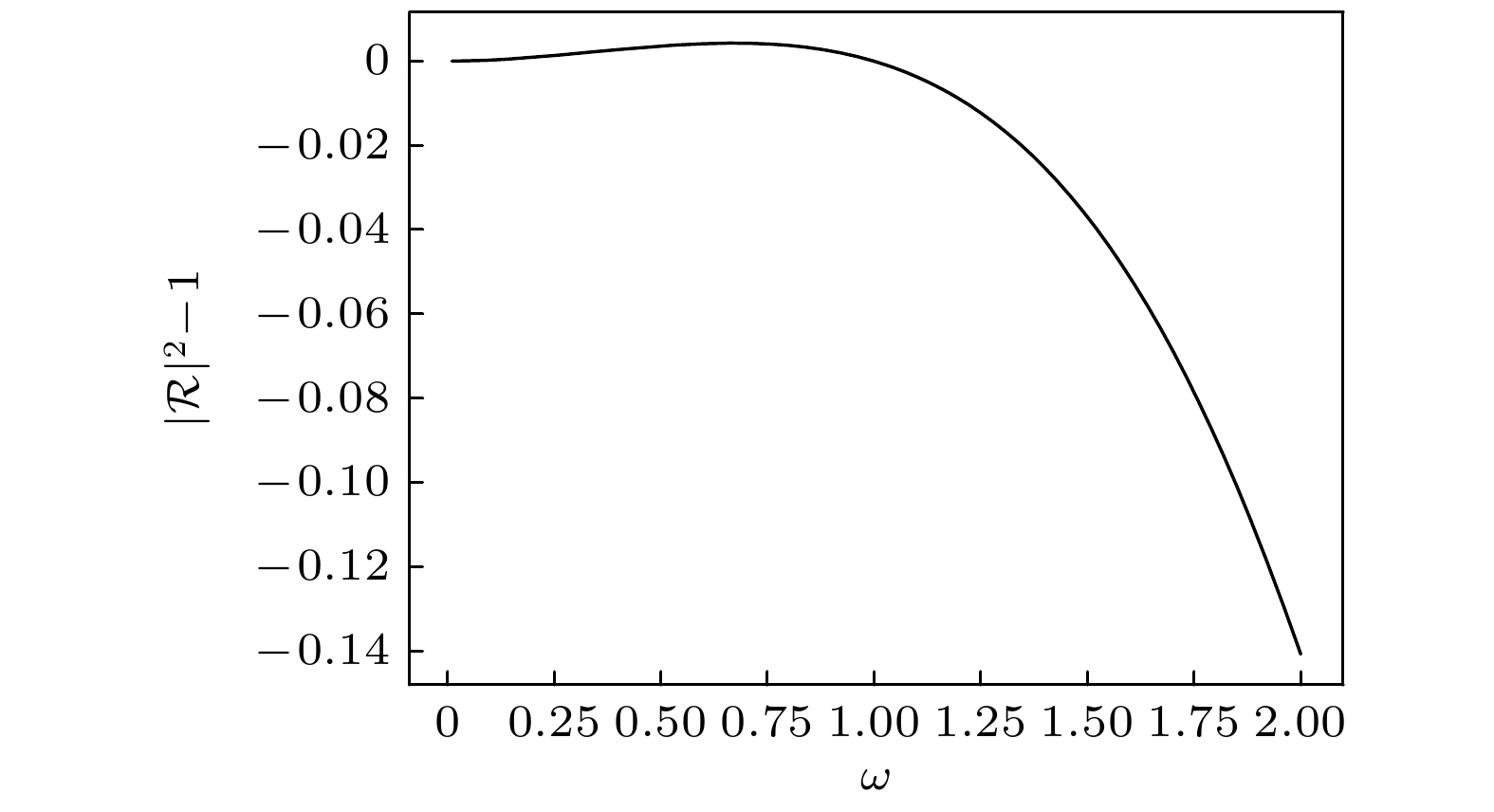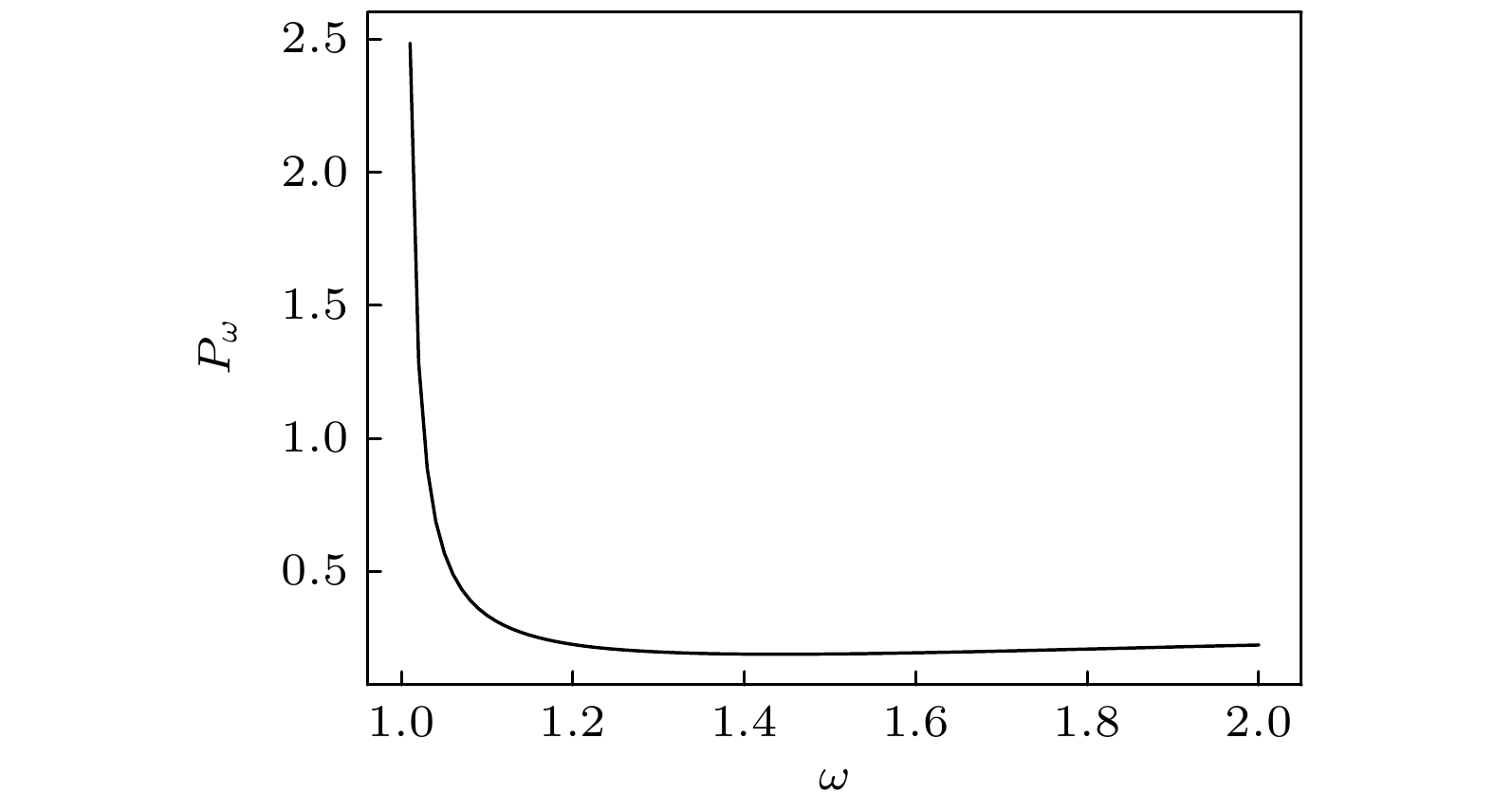-
This paper conducts numerical studies on superradiance and Hawking radiation of a specific rotating acoustic black hole model characterized by parameters A and B, within the framework of analogue gravity. The standard radial wave equation for scalar perturbations in the effective metric of this model is solved numerically by using an adaptive Runge-Kutta method with tortoise coordinates; this approach necessitates careful numerical inversion of the coordinate transformation near the horizon via a root-finding algorithm. By imposing appropriate boundary conditions, we extract the reflection coefficient $\mathcal{R}$ and transmission coefficient $\mathcal{T}$ in a range of frequencies ω. Our results clearly demonstrate superradiance, with the reflectivity $|\mathcal{R}|^2$ exceeding unity for $\omega < m\varOmega_{\rm{H}} = 1$ (where $m=-1$ and $\varOmega_{\rm{H}}=-1$), which confirms energy extraction from the rotating background. The high accuracy of our method is validated by the flux conservation relation, $|\mathcal{R}|^2 + $$ [(\omega - m\varOmega_{\rm{H}})/\omega]|\mathcal{T}|^2 = 1$, which typically has a numerical precision of $ 10^{-8}$. Furthermore, using the derived Hawking temperature and the rotation modified Bose-Einstein distribution, we calculate the Hawking radiation power spectrum $P_\omega$, and use the numerically obtained transmission coefficient $|\mathcal{T}|^2$ as the greybody factor of the model. A prominent feature of $P_\omega$ is its sharp enhancement (or divergence) as ω approaches the threshold $m\varOmega_{\rm{H}}$ from above, which is a characteristic directly related to the denominator of the Bose-Einstein factor. This research also reveals that superradiant amplification and Hawking spectrum characteristics are significantly dependent on the specific values of flow parameters A and B, even when the superradiant threshold $m\Omega_H$ is kept unchanged. This detailed numerical study provides quantitative results for the scattering and radiation properties of this model, and also for strong support for the analogue gravity framework.
-
Keywords:
- acoustic black hole /
- superradiance /
- Hawking radiation /
- numerical calculation
[1] Hawking S W 1974 Nature 248 30
 Google Scholar
Google Scholar
[2] Unruh W G 1981 Phys. Rev. Lett. 46 1351
 Google Scholar
Google Scholar
[3] 李传安 2000 物理学报 49 1648
 Google Scholar
Google Scholar
Li C A 2000 Acta Phys. Sin. 49 1648
 Google Scholar
Google Scholar
[4] Visser M 1998 Class. Quantum Grav. 15 1767
 Google Scholar
Google Scholar
[5] Barceló C, Liberati S, Visser M 2005 Living Rev. Relativ. 8 12
 Google Scholar
Google Scholar
[6] Steinhauer J 2016 Nature Phys. 12 959
 Google Scholar
Google Scholar
[7] Ge X H, Sin S J 2010 J. High Energy Phys. 2010 087
 Google Scholar
Google Scholar
[8] Wang Q B, Ge X H 2020 Phys. Rev. D 101 084014
 Google Scholar
Google Scholar
[9] Ge X H, Nakahara M, Sin S J, Tian Y, Wu S F 2019 Phys. Rev. D 99 104047
 Google Scholar
Google Scholar
[10] Ge X H, Sun J R, Tian Y, Wu X N, Zhang Y L 2015 Phys. Rev. D 92 084052
 Google Scholar
Google Scholar
[11] Yuan H, Ge X H 2022 Eur. Phys. J. C 82 566
 Google Scholar
Google Scholar
[12] Ge X H, Wu S F, Wang Y, Yang G H, Shen Y G 2012 Int. J. Mod. Phys. D 21 1250038
 Google Scholar
Google Scholar
[13] Penrose R 1969 Riv. Nuovo Cimento 1 252
 Google Scholar
Google Scholar
[14] Zel’dovich Y B 1971 JETP Lett. 14 180
[15] Starobinsky A A 1973 Sov. Phys. JETP 37 28
[16] Misner C W 1972 Bull. Am. Phys. Soc. 17 472
[17] Basak S, Majumdar P 2003 Class. Quantum Grav. 20 3907
 Google Scholar
Google Scholar
[18] Yu M H, Ge X H 2023 Phys. Rev. D 107 026013
 Google Scholar
Google Scholar
[19] Yu M H, Ge X H 2022 Eur. Phys. J. C 82 985
 Google Scholar
Google Scholar
[20] Yu M H, Ge X H, Lu C Y 2023 Eur. Phys. J. C 83 87
 Google Scholar
Google Scholar
[21] 葛先辉 2025 物理学报 74 081101
 Google Scholar
Google Scholar
Ge X H 2025 Acta Phys. Sin. 74 081101
 Google Scholar
Google Scholar
[22] 方恒忠, 周开虎, 宋玉明 2013 大学物理 32 30
Fang H Z, Zhou K H, Song Y M 2013 College Phys. 32 30
[23] 赵仁, 张丽春, 李怀繁 2008 物理学报 57 7463
 Google Scholar
Google Scholar
Zhao R, Zhang L C, Li H F 2008 Acta Phys. Sin. 57 7463
 Google Scholar
Google Scholar
[24] 赵仁, 张丽春, 李怀繁 2010 物理 学报 59 2982
 Google Scholar
Google Scholar
Zhao R, Zhang L C, Li H F 2010 Acta Phys. Sin. 59 2982
 Google Scholar
Google Scholar
[25] Nam S, Park J D 2009 Class. Quantum Grav. 26 145015
 Google Scholar
Google Scholar
[26] Demirkaya B, Dereli T, Güven K 2020 Phys. Scr. 95 055001
 Google Scholar
Google Scholar
-
图 2 放大系数$ |{\cal{R}}|^{2}-1 $随入射声波频率ω的变化, 该系数大于零的区域$ (0<\omega \lesssim 1.0) $代表超辐射存在的区域, 此图确定了超辐射发生的频率范围, 其上限对应理论阈 值$ m \varOmega_{{\rm{H}}}=1 $
Figure 2. Amplification factor $ |{\cal{R}}|^{2}-1 $ as a function of incident wave frequency ω, the region where this factor is greater than zero $ (0<\omega \lesssim 1.0) $ represents the existence of superradiance, this figure determines the frequency range for superradiance, with the upper limit corresponding to the theoretical threshold $ m \varOmega_{{\rm{H}}}=1 $.
图 3 霍金辐射功率谱$ P_{\omega} $(黑色实线)随频率ω的变化, 特别展示了超辐射临界频率($ m \varOmega_{{\rm{H}}}=1 $)附近的行为, 图中$ P_\omega $为采用自然单位制($ \hbar=k_{\rm{B}}=c=1 $)及特征长度$ r_0=1 $计算得到的无量纲功率谱密度, 代表以$ \hbar c / r_0 $为单位的能量
Figure 3. Hawking radiation power spectrum $ P_{\omega} $ (black solid line) as a function of frequency ω, specifically showing the behavior near the superradiance critical frequency ($ m \varOmega_{{\rm{H}}}=1 $), the plotted $ P_\omega $ is the dimensionless power spectrum density calculated using natural units ($ \hbar= $$ k_{\rm{B}}=c=1 $) and characteristic length $ r_0=1 $, representing energy in units of $ \hbar c / r_0 $.
-
[1] Hawking S W 1974 Nature 248 30
 Google Scholar
Google Scholar
[2] Unruh W G 1981 Phys. Rev. Lett. 46 1351
 Google Scholar
Google Scholar
[3] 李传安 2000 物理学报 49 1648
 Google Scholar
Google Scholar
Li C A 2000 Acta Phys. Sin. 49 1648
 Google Scholar
Google Scholar
[4] Visser M 1998 Class. Quantum Grav. 15 1767
 Google Scholar
Google Scholar
[5] Barceló C, Liberati S, Visser M 2005 Living Rev. Relativ. 8 12
 Google Scholar
Google Scholar
[6] Steinhauer J 2016 Nature Phys. 12 959
 Google Scholar
Google Scholar
[7] Ge X H, Sin S J 2010 J. High Energy Phys. 2010 087
 Google Scholar
Google Scholar
[8] Wang Q B, Ge X H 2020 Phys. Rev. D 101 084014
 Google Scholar
Google Scholar
[9] Ge X H, Nakahara M, Sin S J, Tian Y, Wu S F 2019 Phys. Rev. D 99 104047
 Google Scholar
Google Scholar
[10] Ge X H, Sun J R, Tian Y, Wu X N, Zhang Y L 2015 Phys. Rev. D 92 084052
 Google Scholar
Google Scholar
[11] Yuan H, Ge X H 2022 Eur. Phys. J. C 82 566
 Google Scholar
Google Scholar
[12] Ge X H, Wu S F, Wang Y, Yang G H, Shen Y G 2012 Int. J. Mod. Phys. D 21 1250038
 Google Scholar
Google Scholar
[13] Penrose R 1969 Riv. Nuovo Cimento 1 252
 Google Scholar
Google Scholar
[14] Zel’dovich Y B 1971 JETP Lett. 14 180
[15] Starobinsky A A 1973 Sov. Phys. JETP 37 28
[16] Misner C W 1972 Bull. Am. Phys. Soc. 17 472
[17] Basak S, Majumdar P 2003 Class. Quantum Grav. 20 3907
 Google Scholar
Google Scholar
[18] Yu M H, Ge X H 2023 Phys. Rev. D 107 026013
 Google Scholar
Google Scholar
[19] Yu M H, Ge X H 2022 Eur. Phys. J. C 82 985
 Google Scholar
Google Scholar
[20] Yu M H, Ge X H, Lu C Y 2023 Eur. Phys. J. C 83 87
 Google Scholar
Google Scholar
[21] 葛先辉 2025 物理学报 74 081101
 Google Scholar
Google Scholar
Ge X H 2025 Acta Phys. Sin. 74 081101
 Google Scholar
Google Scholar
[22] 方恒忠, 周开虎, 宋玉明 2013 大学物理 32 30
Fang H Z, Zhou K H, Song Y M 2013 College Phys. 32 30
[23] 赵仁, 张丽春, 李怀繁 2008 物理学报 57 7463
 Google Scholar
Google Scholar
Zhao R, Zhang L C, Li H F 2008 Acta Phys. Sin. 57 7463
 Google Scholar
Google Scholar
[24] 赵仁, 张丽春, 李怀繁 2010 物理 学报 59 2982
 Google Scholar
Google Scholar
Zhao R, Zhang L C, Li H F 2010 Acta Phys. Sin. 59 2982
 Google Scholar
Google Scholar
[25] Nam S, Park J D 2009 Class. Quantum Grav. 26 145015
 Google Scholar
Google Scholar
[26] Demirkaya B, Dereli T, Güven K 2020 Phys. Scr. 95 055001
 Google Scholar
Google Scholar
Catalog
Metrics
- Abstract views: 2704
- PDF Downloads: 154
- Cited By: 0















 DownLoad:
DownLoad:



